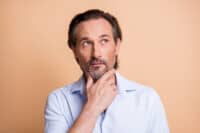
This post may contain links from our sponsors and affiliates, and Flywheel Publishing may receive
compensation for actions taken through them.
If you’re thinking about retiring, you may want to lower your risk.
At the moment, a lot of people have too much exposure to stocks and stock funds. And while stocks are attractive long-term investments, they will also fluctuate significantly. Not only can that be too aggressive, it can be a problematic blunder.
Key Points About This Article:
- People have too much exposure to stocks and stock funds. And while stocks are attractive long-term investments, they will also fluctuate significantly.
- You want to do your best to avoid the sequence of returns risk, which is the risk of negative market returns late in your working years or even in retirement.
- Also: Take this quiz to see if you’re on track to retire(Sponsored)
For example, if you retired at the end of 2008 and were only invested in the S&P 500, your assets fell by nearly 40%. That wasn’t great news for those even thinking of retiring. Instead, what you want to do before you retire is lower your overall risk with assets such as bonds, cash or even CDs. Plus, it never hurts to sit with your financial advisor.
Also, you want to do your best to avoid the sequence of returns risk, which is the risk of negative market returns late in your working years or even in your early days of retirement. After all, at this stage of your life, market downturns can have a far more detrimental impact on your savings because you don’t have the luxury of time for the investments to recover.

Signs Your 401(k) is Too Aggressive
No. 1: Your 401(k)-balance fluctuates too often.
While it’s always great to see you balance go up in up markets, they can quickly go south in unpredictable down markets. That you want to avoid, which you can do by lowering your overall risk with the addition of bonds, cash and CDs.
No. 2: You constantly worry about your 401(k).
If you’re constantly worrying about your 401(k)-portfolio performance, it may be too aggressive with just stocks. Remember, markets don’t just go up. They also unexpectedly come down. If you’re concerned, it’s, again, a good idea to sit with an advisor.
No. 3: Your 401(k) lacks diversification.
A well-crafted asset allocation strategy will help balance your overall risk. In fact, an ideal strategy is to invest in a mixed bag of securities, including stocks, bonds, CDs, cash, and even mutual funds. By doing so, you lower your risk substantially.
Signs Your 401(k) is Too Conservative
A 401(k) can also be too conservative, meaning it has lower growth potential and may not provide sufficient funds needed.
According to Retirement Planning, “While these investments may offer safe returns, they often fail to keep pace with inflation, which can erode the purchasing power of an individual’s money over time. As a result, a conservative 401(k) portfolio may not provide sufficient growth to meet retirement goals or build wealth.”
In fact, if your 401(k) is exposed to a limited range of assets, it may be too conservative. For example, you may have too much exposure to just bonds or CODs where returns may not outpace inflation. We should point out that if you’re not at least earning the inflation rate, you’re actually losing purchasing power over time, which you don’t want to do.
If you do want to diversify your portfolio, start by speaking with your advisor.
Plus, according to BankRate.com, “Some advisors use the rule of 100 to gauge how much to invest in stock and bond funds. With this rule, you subtract your age from 100 to get your stock allocation, with the remainder going into bonds. For example, a 40-year-old should have a 60 percent exposure to stocks and 40 percent to bonds, while a 65-year-old should have 35 percent in stocks and 65 percent in bonds.”
Get Ready To Retire (Sponsored)
Start by taking a quick retirement quiz from SmartAsset that will match you with up to 3 financial advisors that serve your area and beyond in 5 minutes, or less.
Each advisor has been vetted by SmartAsset and is held to a fiduciary standard to act in your best interests.
Here’s how it works:
1. Answer SmartAsset advisor match quiz
2. Review your pre-screened matches at your leisure. Check out the advisors’ profiles.
3. Speak with advisors at no cost to you. Have an introductory call on the phone or introduction in person and choose whom to work with in the future
Thank you for reading! Have some feedback for us?
Contact the 24/7 Wall St. editorial team.




